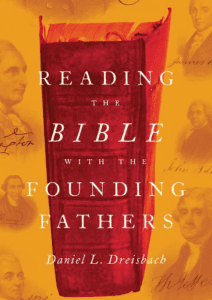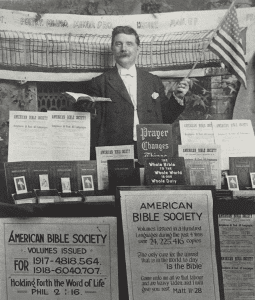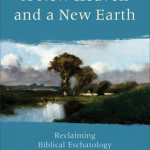 On the inerrancy posts I’ve had a number ask me to explain what I think. When I was a professor at TEDS inerrancy came up often; when I was at North Park, among many evangelical students and a seminary attached to the school and as I got to know Covenant pastors, inerrancy almost never came up; since I’ve been at Northern Seminary it has almost never come up other than in a powerful reconceptualizing and critique of the idea in a chapter by my colleague, David Fitch, in his book The End of Evangelicalism. At Northern I’ve not had a class session where I thought my students thought the Bible was wrong or its truth claims needed to be challenged. Yet the term inerrancy is not how our students — at least in class sessions with me — seem to think about the Bible.
On the inerrancy posts I’ve had a number ask me to explain what I think. When I was a professor at TEDS inerrancy came up often; when I was at North Park, among many evangelical students and a seminary attached to the school and as I got to know Covenant pastors, inerrancy almost never came up; since I’ve been at Northern Seminary it has almost never come up other than in a powerful reconceptualizing and critique of the idea in a chapter by my colleague, David Fitch, in his book The End of Evangelicalism. At Northern I’ve not had a class session where I thought my students thought the Bible was wrong or its truth claims needed to be challenged. Yet the term inerrancy is not how our students — at least in class sessions with me — seem to think about the Bible.
So back to the question above: What do I think? Four thoughts, and I want you to know that these thoughts come after decades of listening to debates and discussions and defenses and ripostes, and after writing about the Bible for going on thirty years. I have for years said the first and leading word for Scripture needs to be truth. I stand by it and it puts the entire inerrancy discussion into a larger context.
Here’s the first: The term itself, not a big idea behind it, has become a distraction as the chps in Five Views of Biblical Inerrancy themselves clearly show: instead of pointing the church toward how to sit before the Bible and listen to the Bible, the term itself generates a debate about how best to define the term and about how to read Joshua 6 and Genesis 1-2, and many things besides. This is what inerrancy term does every time it enters the room, and in so doing deserves a good thrashing. Read the chapters and then ask yourself this question: Will this book generate light for Sunday School classes on how to read the Bible or a fight on how to assess who stands where? Does it bring light or a fight? The latter is what happens.
The term, so it seems from a book like this, may have lost its value for church life. The word we ought to be fastening onto is the word truth. The Bible is true and God calls us to listen and to learn and to live what God speaks to us from the true Word of God. This posture of listen-to-the-truth before the Bible does not determine a hermeneutic but invites us to listen until we discern the hermeneutic needed for the various texts.
My second point might be controversial for some, but I believe it. There is only one real view of inerrancy because this term has been captured by Mohler and those who stand with Mohler. It is the historical hermeneutic agenda. The test cases prove this point: each of the texts chosen concerns a historical hermeneutic agenda and asks Is the Bible accurate? No one asked anyone to assess simply the violence of God in warfare in Deuteronomy. No one asked about cutting off hands in Exodus. No one asked about women taken as booty. No one asked about slavery in the Bible. No one was asked about truth but about accuracy. The only inerrancy I have ever known about is historical hermeneutic accuracy inerrancy. Any text that appears to be history-referring must be history-referring because the alternative conclusion, that it might not be accurate as we want it to be accurate, threatens the system. What Mohler, Bird and Vanhoozer won’t admit is a view that contends that since the historians and archaeologists don’t think what the text says is how things happened the interpretations have to be adjusted, out of respect for historical realities, in order to meet the evidence.
Mohler’s view, or this history-referring inerrancy, is at work in a Bible scholar, Bird, and a sophisticated hermeneutician, Vanhoozer. (Bird’s sophisticated too, at least as much as that red-headed Ozzie can be.) Read how they treat Joshua 6 — in the end, inerrancy is itself a hermeneutic that takes the face value of a text automatically to mean historicity, has an interpretive tradition along that line, and if that historicity can’t be demonstrated, cast aspersions on the scholarship of the archaeologists or hold out until the historical interpretation can be proven (even if there is no end in sight). So, Bird and Vanhoozer can finesse their hermeneutics all they want but when it comes to a historically problematic text they have already chosen on the basis of their view of inerrancy what the text has to have meant. What I saw in all three attempts was a persistent, stubborn refusal even to countenance the view of the archaeologists. The only archaeological theories permitted on the table were the ones that confirmed what they already knew from their inerrancy theory — as history-referring if the plain reading seems so — had to be the case.
Before I get to a third point I want to offer an example of my own on how I think inerrancy operates as captured by the historical hermeneutical approach.
Open your Bible to Matthew 8:5-13. Here are the two verses (5-6) that matter:
When Jesus had entered Capernaum, a centurion came to him, asking for help. 6 “Lord,” he said, “my servant lies at home paralyzed and in terrible suffering”
Matt. 8:7 Jesus said to him, “I will go and heal him.”
A plain reading of the text says that an actual centurion approached Jesus physically and asked him for help and Jesus told that same centurion that he would go to that man’s house and heal his servant. Every inerrantist would make these details important if you denied it.
Now look at Luke 7:1-10. Here is what we suddenly realize: the centurion himself did not in fact speak with Jesus. His elders did:
2 There a centurion’s servant, whom his master valued highly, was sick and about to die. 3 The centurion heard of Jesus and sent some elders of the Jews to him, asking him to come and heal his servant. 4 When they came to Jesus, they pleaded earnestly with him, “This man deserves to have you do this, 5 because he loves our nation and has built our synagogue.” 6 So Jesus went with them.
The point is this: a history-referring inerrantist hermeneutic, if we didn’t know of Luke 7:2-6, would know that it was a centurion who came to Jesus and spoke with him. If all a church knew was Matthew, an inerrantist would be up in arms if anyone suggested that No, in fact, it was some elders — not the centurion himself.
But once we have Luke 7:2-6 we realize our perception of a history-referring reading is flat-out wrong. The centurion actually sent some elders. A second text, Luke, clarified the first text, Matthew, and proved our original instincts wrong. We adjust our readings of Matt 8 to Luke 7.
So we, admirably I believe, find a convention that permits explanation: when an ambassador was sent he was the one who sent him. So, the elders are the centurion. I agree, that is what is going on here. We were only led to the convention by the interference of another text, not by the original text (Matthew 8). We let another text reshape our readings of the Matthew text.
Why can’t we let the historian’s and archaeologist’s evidence do the same for us for Joshua 6? Why can’t we at least look for a convention that explains why the archaeology says one thing and the text says another? (And Joshua 6 is but one example.) Because we have a plain-reading, history-referring inerrantist hermeneutic at work that won’t permit such adjusted reading (unless, of course, we are forced — as we are in the Matt-Luke parallel — by the Bible itself to think otherwise). Too many inerrantist hear of such things and utter out, in effect if not in these terms, “Damn the archaeologists, this is the inspired Bible and it’s right and they’re wrong.” Most inerrantists try to wiggle out of the archaeology on Joshua by tossing dust in the archaeologists’ eyes and then announce their vision is blurry. While the blurred vision settles down the inerrantists change the discussion. It’s not good scholarship.
My contention is fairly simple and straightforward: we ought to let all the evidence determine what a text is actually saying and doing and not our assumptive readings. Which means no term other than “true” ought to shape our hermeneutic. The word “true” is bigger than the word “inerrant.” In fact, “true” is the emperor of all biblical hermeneutics. The term “inerrancy” too often usurps the word “true” and the Bible loses.
Third, maybe you think it is unfair to restrict inerrancy to the history-referring, plain-meaning view of someone like Mohler. Maybe there is a second view, one that emphasizes what the Bible is affirming at the level of divine or human intention. So, we ask what was Matthew affirming, what was Matthew’s purpose in Matt 8:5-6? Was he affirming only a centurion? Or was he affirming that a centurion made contact with Jesus, however that contact was made?
I see this emphasis on intention and purpose in the essays of Enns, Bird, Vanhoozer and Franke. I believe an emphasis on intentionality or purpose in Scripture, or on the pragmatics of the text, can reshape the meaning of inerrancy. It can, but it will mean far more emphasis on hermeneutics and theology at work in the purpose of the author/God/text than is often acknowledged. A ringer: John Piper’s view of inerrancy is very much along this line, and such a view would permit Robert Gundry’s theory of midrash in Matthew, Michael Licona’s view of the resurrection of the saints, as well as some mythical and exaggerations in Old Testament stories, including Joshua 6. Here is Piper’s own statement followed by Bethlehem Baptist’s statement:
I thus gladly align myself with the long-proved tradition: perfectio respectu finis(perfection with respect to purpose).
We believe that God’s intentions, revealed in the Bible, are the supreme and final authority in testing all claims about what is true and what is right. In matters not addressed by the Bible, what is true and right is assessed by criteria consistent with the teachings of Scripture.
I very respect this emphasis on purpose and intention; it admits into the door the messy world of hermeneutics; it permits at the table some voices that today are simply now welcome by many; it means hermeneutics decides genre. The strident strong voices of inerrancy, however, do not permit the purpose/intention dimension unless it already conforms to the history-referring theory already at work. I have on good word that some of the historic major framers of how inerrancy was understood among evangelicals saw the purpose theory of inerrancy as totally inadequate.
Fourth, inerrancy without an ecclesiology or an ecclesial confession/creed leads inevitably to pervasive interpretive pluralism and therefore it diminishes the authority of the Bible to the strongest or most compelling voice on the platform. I am referring here to the important study of Christian Smith, The Bible Made Impossible.
I can open up the floodgates here by suggesting that there is a notable absence of Spirit in the chapters: and I don’t mean just inspiration, but the Spirit as at work, the Spirit at work in people and in the people of God, guiding, leading, inspiring so that Scripture is the effect of God’s communicative action to the people of God through the Spirit in Christ with the result of Scripture. Instead of asking “What” is authoritative?, maybe we need to ask “Who” is authoritative? Scripture is authoritative in that it mediates the authority of God in Christ through the Spirit. Our authority then is God.
Maybe the history-referring, accuracy-oriented inerrancy has to focus on the original autographs while the purpose-oriented framing of the issues might have an opportunity to focus on the Spirit — the Spirit at work through Scripture — instead of the original autographs, which we don’t have and God didn’t seem to think we needed. Why? The Spirit and the church and the gifts.
Having now shown my cards of the church in the plan of God’s communicative action, I can cite an ecclesial statement to which I subscribe:
Here is the Anglican Church of North America’s wise statement on its view of Scripture:
We confess the canonical books of the Old and New Testaments to be the inspired Word of God, containing all things necessary for salvation, and to be the final authority and unchangeable standard for Christian faith and life.
I think Mike Bird would see this as part of the infallibilist tradition, and I would see it that way too. But notice the positive terms. Inerrancy means “not in error.” At any rate, I affirm the ACNA’s orientation and it can guide Bible reading for me.
At the core of Bible reading is knowing what the Bible is doing, and the essays had something like this going on. Vanhoozer was the most explicit though Franke was close. What ought to be going on is a gospel hermeneutic that will render meaning for us as we encounter texts through the truth about Jesus, the gospel. Pete Enns calls this a christotelic reading and this sort of approach governed the earliest Christians (Jesus and the apostles) when they read (what we call) the Old Testament. Perfect example from Jesus in Luke 24:
Luke 24:44 He said to them, “This is what I told you while I was still with you: Everything must be fulfilled that is written about me in the Law of Moses, the Prophets and the Psalms.”
Luke 24:45 Then he opened their minds so they could understand the Scriptures. 46 He told them, “This is what is written: The Christ will suffer and rise from the dead on the third day, 47 and repentance and forgiveness of sins will be preached in his name to all nations, beginning at Jerusalem. 48 You are witnesses of these things. 49 I am going to send you what my Father has promised; but stay in the city until you have been clothed with power from on high.”
Open to Matthew 1-2, to Paul in most any of his letters, to the Book of Hebrews or to Revelation. Over and over they are reading the Bible through the lens of the gospel, the truth, which as you may know I take to be the story of Israel fulfilled in the story of Jesus so that christology (not soteriology) gets the first word. If Jesus was raised from the dead your hermeneutic is transformed into a gospel hermeneutic.
Vanhoozer’s essay wanted to back off for the big theme: God’s promise to give the Land to the children of Israel is what this text is about. He’s right. Now guide us from there to Jesus and the gospel and we’ll be reading the Bible the way Jesus and the apostles did, we will be reading the Bible in a way that brings the sun’s true light of life to the church, and in a way that avoids the wrangling that inerrancy inevitably creates. I could say this of the others.
Inerrancy is a disruptive child in the theological classroom. He or she gets all the attention of teacher and students. A biblical view of inerrancy demotes it under the word true, all as part of God’s choice to communicate efficiently and sufficiently. When the word “true” governs the game it’s a brand new, healthy game. Good teachers know how to handle disruptive children.











